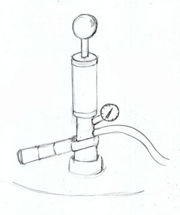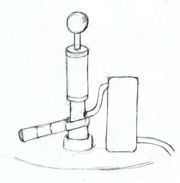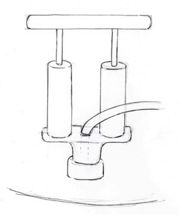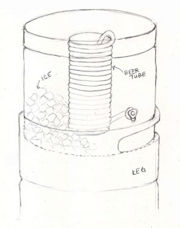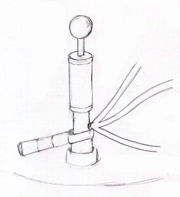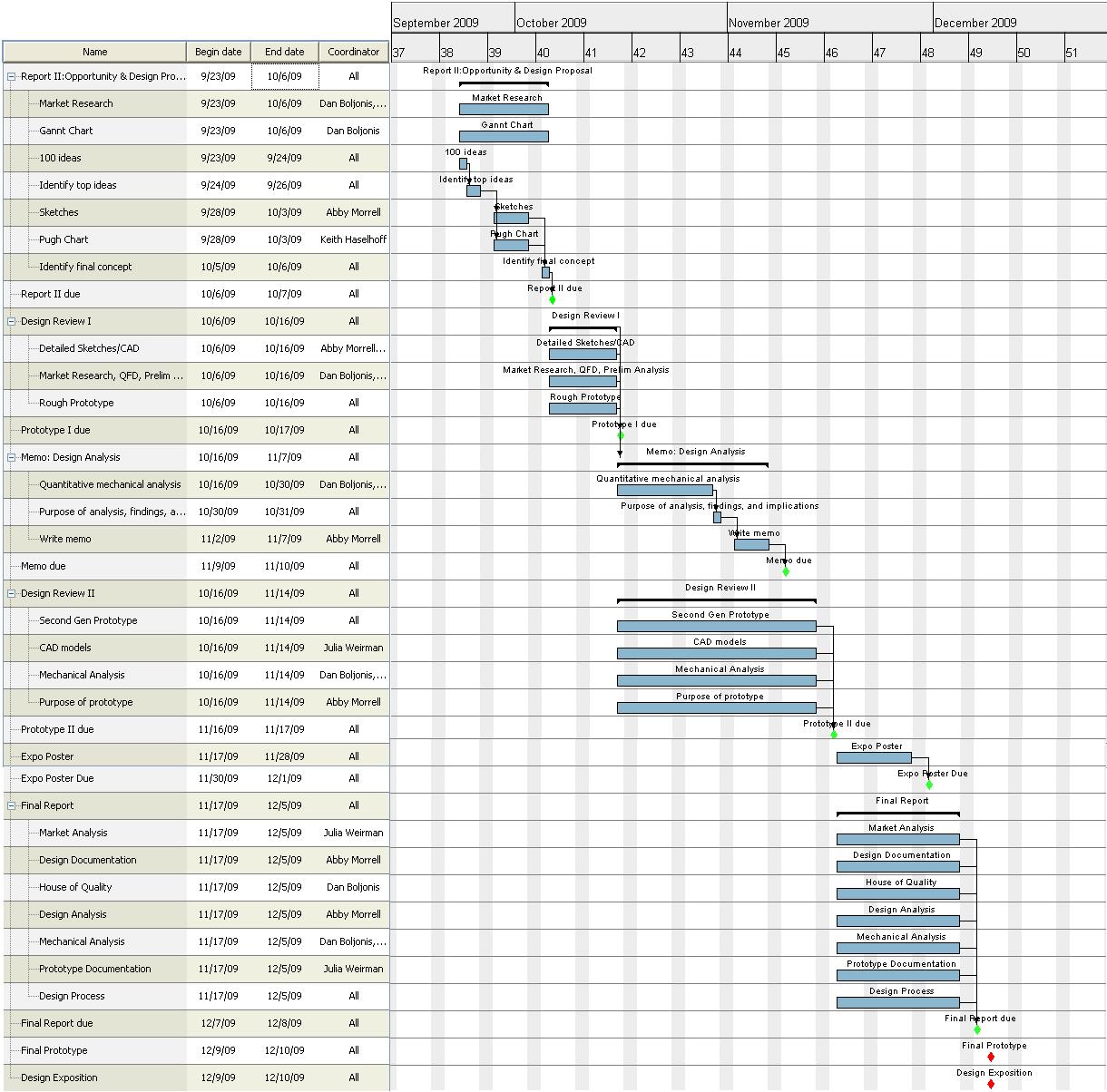Keg tap redesign
From DDL Wiki
(→Team Member Roles) |
(→Market Research) |
||
| Line 18: | Line 18: | ||
==Consumers== | ==Consumers== | ||
| - | For consumers, we distributed a survey to students, young professionals, and adults in order to get responses from a representative sample of all potential keg tap users. The goals of the survey were to identify the target demographic, key complaints, advantages and disadvantages of keg use as opposed to bottles, and other customer needs. | + | For consumers, we distributed a survey to students, young professionals, and adults in order to get responses from a representative sample of all potential keg tap users. The goals of the survey were to identify the target demographic, key complaints, advantages and disadvantages of keg use as opposed to bottles, and other customer needs. From the survey results, we found that consumers mainly desire the following: |
| + | |||
| + | * Intuitive tap design | ||
| + | * Reduced foam output | ||
| + | * Simple way to keep keg cold | ||
| + | * Better pumping mechanism | ||
| + | * Faster dispensing method | ||
| + | |||
| + | The survey questions along with common responses are summarized below. | ||
===Keg Use Survey=== | ===Keg Use Survey=== | ||
| Line 124: | Line 132: | ||
* Keep cost down (no CO2 canisters) | * Keep cost down (no CO2 canisters) | ||
<br /> | <br /> | ||
| - | |||
| - | |||
| - | |||
| - | |||
| - | |||
| - | |||
| - | |||
| - | |||
==Results Summary== | ==Results Summary== | ||
| - | The market research demonstrates that there are many potential areas for improvement in keg tap design. Beer distributors desire a durable tap that is easy to disassemble and clean. Consumers focus more on use issues such as foamy beer, keeping the keg cold, difficulty pumping, and standing in long lines to fill a cup. | + | The market research demonstrates that there are many potential areas for improvement in keg tap design. Beer distributors desire a durable tap that is easy to disassemble and clean. Consumers focus more on use issues such as foamy beer, keeping the keg cold, difficulty pumping, and standing in long lines to fill a cup. Some user complaints can be attributed to misuse of the tap. Misuse could be easily prevented by providing directions, but based on the nature of the product, directions would probably never be read. Alternatively, the keg tap could be constructed in a more intuitive way, have arrows printed on it demonstrating the proper tapping method, or include a pressure gauge to indicate how many pumps are needed to dispense non-foamy beer. |
| - | + | ||
| - | Some user complaints can be attributed to misuse of the tap. Misuse could be easily prevented by providing directions, but based on the nature of the product, directions would probably never be read. Alternatively, the keg tap could be constructed in a more intuitive way, | + | |
| - | + | ||
| - | + | Due to the large percentage of responses complaining about the foam, much of our brainstorming focused on fixing that problem. We also had multiple ideas for improving access to the beer and cooling it more efficiently. The keg tap redesign concepts reflect what we have determined to be the leading market needs. | |
=Design Concepts= | =Design Concepts= | ||
Revision as of 22:32, 6 October 2009
Contents |
Executive Summary
Market Research
The two markets researched were consumers and beer distributors. We conducted interviews and collected survey responses to gain insight as to what customers look for in a keg tap and gauge market need.
Beer Distributors
To determine the needs of beer distributors, we interviewed the store managers. We found that most distributors own about 50 taps and need to restock every few months. They restock mainly because customers do not return the taps after use. We also found that workers routinely disassemble the taps for cleaning. From these interviews, we learned that beer distributors want keg taps that are:
- Easy to disassemble
- Composed of standard parts to facilitate part replacement
- Simple to clean
- Durable enough to withstand customer abuse
Consumers
For consumers, we distributed a survey to students, young professionals, and adults in order to get responses from a representative sample of all potential keg tap users. The goals of the survey were to identify the target demographic, key complaints, advantages and disadvantages of keg use as opposed to bottles, and other customer needs. From the survey results, we found that consumers mainly desire the following:
- Intuitive tap design
- Reduced foam output
- Simple way to keep keg cold
- Better pumping mechanism
- Faster dispensing method
The survey questions along with common responses are summarized below.
Keg Use Survey
For the following survey, over 100 responses were collected: approximately 85% from college students, 10% from young professionals, and 5% from adults. About three-quarters of those surveyed drink from a keg a few times a month; the remainder reported consuming beer from a keg on a less regular basis (a few times a year, used to in college but no longer do, and never). The questions are based on home keg use as opposed to beer on tap at bars.
1. What issues have you experienced getting beer out of a keg?
Of the approximately 100 people surveyed, 90% had issues with too much foam, 81% experienced long lines to fill up their cup, and 50% found it difficult to pump the tap.
Other issues included:
- Tap dispensing beer too slowly
- Difficulty getting the last bit of beer out of the keg
- Trouble with keg stands
- Tap breaking
2. What are some advantages/disadvantages to buying a keg instead of cans or bottles?
Advantages:
- Much cheaper than cans/bottles
- Reduced waste and smaller environmental impact
- Easier to clean up
- Carbonation level better from keg
- Assuming the keg is new/has been well taken care of, the beverage quality is generally higher (less chance of skunking or tasting like metal)
- Easier to provide for large groups of people
- Can be delivered
- Don’t need to search for a bottle opener.
Disadvantages:
- Have to return keg
- Keg needs to stay cold until you’re done with it
- Less variety with kegs than bottles and cans
- May be tougher to monitor consumption i.e. not knowing what is in a certain guest’s cup and harder to keep track of the number of beers you’ve had when refilling a cup
- Negative perception of “keggers” versus a more mature party with premium beers
- Finding a place to put the keg
- Accepting that kegs are unattractive
- Tap could break
- If keg isn't finished the beer will go bad and be a waste
- Kegs are heavy and hard to move
- Issues with foam
- Kegs are banned at some schools
3. What events would you purchase a keg for?
- Any large, casual party
- Tailgating
- Barbeques
- Camping
4. Have you ever tapped a keg? What problems did you have, if any?
- The tap would not stay screwed into the keg (may have been broken)
- Difficult to screw the tap on properly
- Not familiar with type of tap (keg tap not intuitive)
- Beer sprayed all over the place because of old or broken seal
- Pressure lost so the keg had to be retapped
- Incompatible tap-keg connections
5. What would you look for when purchasing a keg tap?
- Large, stationary upright tap as opposed to a long tube and tiny nozzle
- Sturdy feel (the piston doesn’t wobble)
- Low cost
- Durable
- Good pumping and dispensing mechanisms
- Quality materials
- Intuitive/Easy to use
- Multiple nozzles
- Good grip on the dispenser
- Lightweight
- Easy to wash
- Long hose with a sturdy nozzle
- Compatible with a broad array of kegs
- Maximum beer flow
6. How could your overall keg experience be improved?
- Way to chill keg
- Pressure gauge to prevent over pumping
- Make a keg like a Gatorade cooler with a spigot at the bottom and no tap
- Handle that doesn't protrude so far off the keg (pump handle like most large ketchup dispensers)
- Eliminate foam
- Multiple hoses
- Push a button to automatically pump the keg to an optimal pressure
- Stronger flow from tap
- Way to preserve beer left over in keg so it doesn't go bad
- Keg with wheels for ease of transport
- Add light so that you can see where you’re pouring at night
- More suitable for keg stands
- More intuitive
- Rubber on keg handles to make carrying it easier
- Have only open or closed option for nozzle
- More pressure per pump (foot pump?)
- Keep cost down (no CO2 canisters)
Results Summary
The market research demonstrates that there are many potential areas for improvement in keg tap design. Beer distributors desire a durable tap that is easy to disassemble and clean. Consumers focus more on use issues such as foamy beer, keeping the keg cold, difficulty pumping, and standing in long lines to fill a cup. Some user complaints can be attributed to misuse of the tap. Misuse could be easily prevented by providing directions, but based on the nature of the product, directions would probably never be read. Alternatively, the keg tap could be constructed in a more intuitive way, have arrows printed on it demonstrating the proper tapping method, or include a pressure gauge to indicate how many pumps are needed to dispense non-foamy beer.
Due to the large percentage of responses complaining about the foam, much of our brainstorming focused on fixing that problem. We also had multiple ideas for improving access to the beer and cooling it more efficiently. The keg tap redesign concepts reflect what we have determined to be the leading market needs.
Design Concepts
Based on our survey results, the key areas of improvement are foam reduction, keg refrigeration, and line reduction. While the 5 main concepts below fulfill these specific areas, other improvements will also be made. Ease of use, environmental impact, cost, and aesthetics will all be taken into account, and general improvements in these areas will be automatic. A more comprehensive list of ideas can be found in the appendix.
Issue 1: Foam Reduction
Concept Solutions:
- Pressure Gauge
A simple pressure gauge is something that could limit the chance of misuse by telling the user when the keg is at the ideal pressure. If we also added a release valve, this would take it a step further by entirely preventing the user from over-pumping. Ideally the gauge would be attached to the tap at the point where air is coming back out of the keg. An illustration of this is shown in Figure 1.
- Separate Beer Reservoir
A separate beer reservoir is another concept idea that would reduce foam. By having the beer enter a separate container at a high point and exit at a low point, the foam would ideally rise to the top, while the beer would exit out the hose. Whether the separate reservoir is internal or external is yet to be determined. An illustration of this general concept can be seen in Figure 2.
- Double Barrel Pump
The Double Barrel Pump is a concept that could potentially both reduce foam and facilitate pumping. With more air going into the keg, less pumps would be necessary. Also, this design would change the center cylinder, which is a key source of turbulence. In the Double Barrel Pump design, the beer would flow in a straight path, while the air flow would have a curved path. This is the opposite from standard center cylinders, where the beer is forced around many sharp turns and tight corners. An illustration of the double barrel pump is shown in Figure 3.
Issue 2: Keg refrigeration
Concept Solution:
- Coiled tubes in ice bath
Since finding containers to hold a keg can often be difficult, and the ice can be messy, this solution would minimize these issues. A container would be placed on top of the keg with the beer tube coiled around a centered cylinder. The container would then be filled with ice in order to cool the beer flowing out of the tube. It would probably take quite a length of tubing, but this could be determined by applying heat transfer calculations. Also, the shape of the container might change depending on whether it is manually pumped (there would need to be a hole to access the plunger), or if it would have a built-in C02 canister to regulate the pressure. A general illustration of this concept is shown in Figure 4.
Issue 3: Distribution Improvement
Concept Solution:
- Multiple hoses
Multiple hoses is a relatively simple solution to minimizing the waiting period for a beer. This is an idea that would definitely have to be paired with another concept, as it doesn't help to limit foam. While the illustration shows hoses coming out of the same opening in the tap, this might not be the case. Also, the tubing could potentially be elimated in favor of a series of spouts. A concept sketch is shown in Figure 5.
Competitor Products
After doing multiple searches and interviewing the owner of a large beer distributor some competing products were identified in the table. These products were all found on a website that was given to us by the beer distributor. The "Tap with Spout", "Jockey Box", and "Multiple Hoses" pictures were all taken from references 1, 2, and 3 respectively. In addition to the competing products we found, we also listed our five best designs and compared them all to the tap we tore apart in the following Pugh chart.
As you can easily see our designs were thought of in attempt to fix certain complaints from our user surveys. The first three designs are our attempts to reduce foam, the fourth is to cool the beer, and the last attempts to serve the beer more quickly. Our designs to reduce foam seem to be promising as competitors seem to be lacking there. We also feel as though some of our designs may be easier to use than current taps. Out performing our competition in these two categories is at the top of our list of things to accomplish. That being said we have thought of multiple ways to combine some of these ideas in order to increase the positive aspects from our redesign.
Design Plan
Key Findings
By looking at the results from user testing, the survey, and Pugh chart, we have found that a combination of our concepts is necessary. When looking at competitor products, we noticed that there aren't any attempts at foam reduction for personal keg use. And while we found competitors to have several efficient ways to cool beer, they were all very costly. Thus, we recommend combining 2 of the foam reduction concepts with one of the other areas of improvement. Specifically, we recommend combining the pressure gauge, to limit misuse, the double barrel pump, to facilitate pumping and improve the center cylinder, and a multiple hose attachment to accomodate more than 1 person at a time. In an ideal situation, the beer would have the right amount of foam, it would be dispensed quickly, and it would be more easily tapped. We believe that these needs can be met more closely by combining our concepts.
Team Member Roles
While the majority of the sections were done by the group as a whole, each person helped in the following areas:
Dan Boljonis: Gantt chart, market research
Keith Haselhoff: Competitor research, Pugh chart
Abby Morrell: Design Concept sketches and descriptions, Findings & Recommendations
Julia Weirman: Market research, created survey and compiled results, executive summary
References
- http://www.micromatic.com/draft-keg-beer/keg-pumps-cid-829.html
- http://www.micromatic.com/draft-keg-beer/jockey-boxes-cid-163.html
- http://www.micromatic.com/draft-keg-beer/keg-pumps-cid-2467.html
Appendix
Brainstorming Ideas:
- Pressure meter
- Pressure release valve
- Flat surface to put cup on
- Multiple cup holders
- Adjustable cup holder
- Multiple hoses
- Instead of hoses have a reservoir with spouts
- Flatten the keg on one side
- Carbon Dioxide canister
- Keg stand helper
- Wheels on keg
- Flatter, more rectangular handle
- Strap for carrying keg
- Motorized keg
- Tubing to cool beer
- Cooling Koozie
- Insulated keg
- Instructions for tapping
- Larger diameter hose
- Empty-full gauge
- Cup dispenser
- Pong ball dispenser
- Quarter dispenser
- Fold-out table
- Keg grill
- Pump into separate reserve
- Cooled reserve
- Hose-less nozzle
- Breathalyzer
- Flow straightener
- Separate center cylinder
- Way to suck out foam faster
- Button to tap keg instead of pump
- Recirculate foam back into keg
- External primer
- Internal chamber to recirculate foam
- Different locking mechanism
- Self-assembled tap (compact packaging)
- Put some substance into keg to reduce foam (like Guinness bottles)
- Put some substannce into tap to reduce foam
- Keg can play music when pumped
- Charges ipod with pumping
- Nozzle only open or close
- Koozie to insulate keg
- Beer counter
- Pump counter
- Measuring device to dispense only certain amount of beer
- Plastic keg tap
- Novelty keg taps with different characters (ie. Peter Griffin, Ninja Turtles, Statue of Liberty)
- Keg tap with audio
- Voice-activated pressure gauge
- Magic 8 ball keg tap
- Sanitizer
- Glow in the dark keg tap
- Flashlight attached to nozzle
- Attach different beverage to nozzle to make mixed drinks
- Different nozzle heads (Spray, jet)
- Foot pump tap
- Electric motor
- Multiple kinds of beer in 1 keg
- Disco-light tap
- Fog machine
- Foam machine
- Gargoyling assist
- Turn a wheel instead of pumping
- Clear tube to see foam
- Plexiglass keg
- Strip of plexiglass to show beer level
- Plexiglass top only
- Recognition system (Only one person can tap keg)
- Theft reduction system
- Vending machine keg (Quarter per beer)
- Tells alcohol percentage
- Removable hose, different attachments
- Water fountain tap
- Beer flows out over fountain
- Disposable nozzle cover
- No lever arm on tap (twists into place)
- Make everything stainless steel
- Diamond keg tap
- Bigger center cylinder
- Hose attachment at angle or straight up
- Offset pump so beer comes out straight
- Double barrel pump (balances out moment)
- Use outlet tube to pump (no turns)
- Pump like ketchup dispenser
- Universal attachment (works for all kegs)
- Ice container with coils for cooling beer (sits on keg, attaches to tap)
- Dishwaster safe
- Garden hose nozzle adapter for easy cleaning (flush with water)
- Retractable hose (like in sink)
- Hose comes coiled, tap has holder
- Instead of flowing through coils, beer flows over cold surface into cup
- Handle turns red when keg nears empty
- Rack for holding keg
- Container that has drain for water when ice melts
- Holder to place cup at proper angle
- Thermo-electric cooling keg
- Comfort grips for keg stands
- Camouflage keg
- American pride keg
